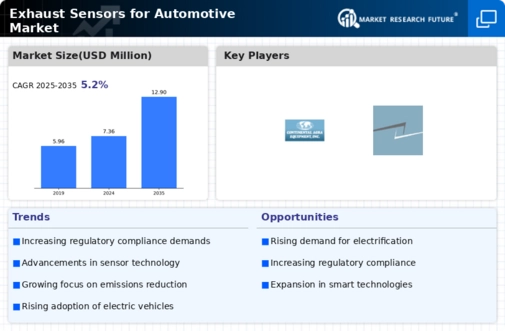Automotive Exhaust Sensors Size
Automotive Exhaust Sensors Market Growth Projections and Opportunities
The market for exhaust sensors in the automotive industry is heavily influenced by several key factors. These factors play a significant role in shaping the demand, supply, and overall dynamics of this market segment.
First and foremost, government regulations and emission standards have a profound impact on the exhaust sensor market. With an increasing focus on reducing harmful emissions from vehicles, governments around the world are implementing stringent regulations mandating the use of advanced exhaust sensing technologies. Automakers are compelled to integrate sophisticated sensors into their vehicles to ensure compliance with these standards, thereby driving the demand for exhaust sensors.
Technological advancements also play a crucial role in shaping the market for exhaust sensors. As automotive manufacturers strive to develop cleaner and more efficient vehicles, there is a continuous need for innovative sensing solutions. Advancements in sensor technology, such as the development of more accurate and durable sensors, contribute to the growth of the market by offering improved performance and reliability.
Additionally, the growing adoption of electric and hybrid vehicles is influencing the demand for exhaust sensors. While these vehicles produce fewer emissions than traditional internal combustion engine vehicles, they still require exhaust sensors to monitor and optimize their performance. As the market for electric and hybrid vehicles expands, so does the demand for exhaust sensors tailored to meet the specific requirements of these vehicles.
Moreover, economic factors such as fuel prices and consumer purchasing power also impact the market for exhaust sensors. Fluctuations in fuel prices can influence consumer preferences towards more fuel-efficient vehicles, driving the demand for exhaust sensors that help optimize fuel consumption. Similarly, changes in consumer purchasing power can affect overall vehicle sales, thereby indirectly influencing the demand for exhaust sensors.
Furthermore, the competitive landscape of the automotive industry plays a significant role in shaping the market for exhaust sensors. As automakers strive to gain a competitive edge by offering vehicles with superior performance and lower emissions, they rely on advanced sensing technologies to achieve these objectives. This creates opportunities for sensor manufacturers to innovate and differentiate their products, thereby driving competition within the market.
Supply chain factors also play a crucial role in determining the availability and pricing of exhaust sensors. The availability of raw materials, components, and manufacturing capabilities can impact the production capacity and cost structure of sensor manufacturers. Additionally, factors such as geopolitical tensions, trade policies, and logistics can affect the smooth functioning of the supply chain, leading to potential disruptions in the availability of exhaust sensors.
Lastly, consumer preferences and trends also influence the market for exhaust sensors. As consumers become more environmentally conscious, there is a growing demand for vehicles with lower emissions and higher fuel efficiency. This trend drives automakers to invest in advanced sensing technologies, including exhaust sensors, to meet the evolving needs and preferences of consumers.
In conclusion, the market for exhaust sensors in the automotive industry is shaped by a complex interplay of factors including government regulations, technological advancements, vehicle electrification, economic conditions, competitive pressures, supply chain dynamics, and consumer preferences. Understanding and effectively navigating these market factors are essential for stakeholders within the automotive ecosystem to capitalize on the opportunities and mitigate the challenges within this dynamic market segment.






Leave a Comment